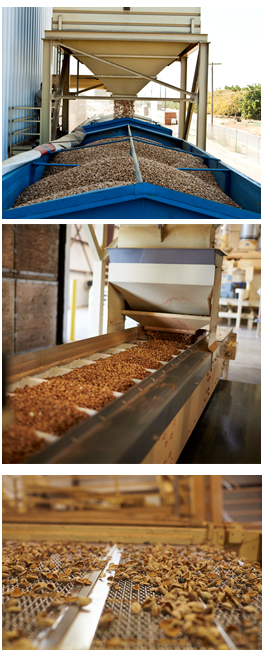This post was written by Almond Board intern Allie Assali, part of a third-generation almond growing and handling family located in Stanislaus County, Calif. Focusing on industry relations with a background in agricultural economics and marketing, Allie brings her grower and handler perspective to her activities at the Almond Board.
 Thirty years ago my grandfather, Frank Assali, planted his first orchard and developed a love for growing almonds. Five years later, he and my grandmother followed their dream of taking care of almonds all the way from the tree to the table, and they built a hulling and shelling facility. At a huller and sheller, the almonds are brought from the orchard and sent through machinery to become ready for consumers to eat. Today, all three generations of my family are active in the day-to-day operations. It doesn’t take much time with my grandfather to see his two loves surface -- he loves his family, and he loves to farm. The business he created allows him to live each day surrounded by both.
Thirty years ago my grandfather, Frank Assali, planted his first orchard and developed a love for growing almonds. Five years later, he and my grandmother followed their dream of taking care of almonds all the way from the tree to the table, and they built a hulling and shelling facility. At a huller and sheller, the almonds are brought from the orchard and sent through machinery to become ready for consumers to eat. Today, all three generations of my family are active in the day-to-day operations. It doesn’t take much time with my grandfather to see his two loves surface -- he loves his family, and he loves to farm. The business he created allows him to live each day surrounded by both.
There are more than 100 handlers (hulling and shelling facilities) and approximately 6,800 almond growers in California. My grandfather wears two hats. First, he is an almond grower just like our customers. He understands the work it takes throughout the season to grow a crop. Almond growers work all year making their best management decisions in hopes for a large, high-quality crop.
Second, my grandfather is a handler. It is up to him to ensure that the plant runs properly and each grower’s crop is well taken care of after it leaves the orchard – that the hulls and shells are separated from the almonds and put to other uses, and that the almonds are sorted and graded according to size and quality.
The hulling and shelling process is the last step of the harvest each year. After the almonds are shaken off the tree and swept into rows, they’re picked up using a pick-up machine. My grandfather works to ensure that the impacts of harvest are minimal, reducing impacts on our neighbors and people who are driving nearby.
When almonds leave the orchard, they do not look like the almonds found in a grocery store. There’s work involved to remove the outer coverings, which is why hulling and shelling facilities exist. But nothing goes to waste. The whole almond fruit that is grown on the tree has three parts – the hull, shell, and kernel.
- Hull: The hull is the dry and fuzzy outer layer that covers the shell and kernel. Almond hulls are used as livestock feed, reducing the amount of water used to grow other feed crops. In fact, in Stanislaus County where my family’s farm is, almond hulls rank in the top 10 most valuable crops. [1]
- Shell: The almond shell protects the kernel throughout the growing season and must be cracked off to reach the almond kernel. Shells are used as an alternative fuel to produce electricity through cogeneration, and they’re also used as livestock bedding.
- Kernel: The kernel, found inside both the shell and the hull, is the nutrient-rich almond we love to eat. Each ounce of almonds (about a handful) has 6g of plant-based protein, 4g of fiber and 13g of “good” (unsaturated) fat and only 1g of saturated fat.[2]
While at the huller and sheller, almond kernels pass through a mechanical roller that removes the hull, shell and any remaining debris. Then the kernels are sent through a sizer, where the kernels drop into separate bins according to size.
For our almond-growing customers, the annual almond growing season is coming to an end. For my grandfather, the growing season is also ending, but it is just the beginning of another year at the huller and sheller. It is the busiest time of the year for our family as we are in full swing. A typical hulling season will run from August to November, which means a year’s worth of work is done in about four months. Because all almonds are harvested simultaneously, our growers need our hulling and shelling services at the same time. During these months, our staff nearly doubles to ensure the huller and sheller runs smoothly and safely. After the rush of the hulling season, focus shifts to making fixes and upgrades to the equipment as well as preparing for the next year’s almond harvest.
When I asked my grandfather what his job meant to him, he said, “I get to be a part of our growers’ operations. I work hard to service them, but I also give them advice -- farmer to farmer. We are all sort of a big family. And that is what farming is all about.”
[1] Stanislaus County Agricultural Crop Report 2013.
[2] Scientific evidence suggests, but does not prove, that eating 1.5 oz of most nuts, such as almonds, as part of a diet low in saturated fat and cholesterol may reduce the risk of heart disease. Good news about fat. U.S. Dietary Guidelines recommend that the majority of your fat intake be unsaturated. One serving of almonds (28g) has 13g of unsaturated fat and only 1g of saturated fat.